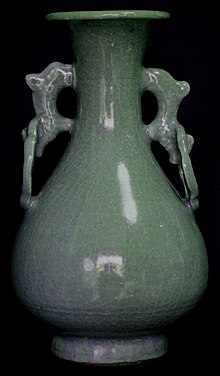Longquan kiln


The Longquan kiln ( Chinese 龙泉 窑 , Pinyin Lóngquán yáo , English Longquan kiln ) is a famous Chinese ceramic kiln ("China kiln") from the time of the Song Dynasty in the southwest of the Chinese province of Zhejiang . It is one of the most famous celadon kilns of ancient China in the southern region.
history
The term Longquan kiln serves as a generic term for several hundred different kilns scattered over a wide area . Its territory extends over Longquan , Wuyi , Yongjia , Wencheng and Taishun in Zhejiang Province . The archaeological site of the Longquan celadon kiln of the Southern Song Dynasty was excavated in 1959. It provides important material for research into the production, types, styles and handicrafts of the Longquan celadon of the Southern Song Dynasty .
An important kiln site was in the villages of Dayao (大 窑) and Jincun (金 村) of the Xiaomei (小梅 镇) community in Longquan , Zhejiang Province . The kiln has its origins in the time of the Five Dynasties , it continued the tradition of the ( Tang-temporal ) Yue kiln and burned celadon . Its heyday fell during the Southern Song Dynasty . The Longquan ceramic kilns of the Southern Song Dynasty can be divided into two types: in one case, the blank is fine-grained and radiant white, in the case of the colored glazes, the light greenish-blue ( fenqing ) and the vinegar-plum-green ( meiziqing ) color are representative, Decorations and appliqués that appear three-dimensional serve as decorative patterns. This type is usually called Di-Kiln ("Kiln of the younger brother"; Chin. Dì yáo 弟 窑); this type is usually always referred to under the name of the Longquan kiln . The other type is usually called the Ge kiln ("Elder Brother's Kiln "; Gē yáo哥窑).
The utensil shapes of the Longquan kiln are very diverse, in addition to household items for everyday use, various writing utensils and various antique-looking vessels were also burned. During the time of the Mongol dynasty , its ceramics were exported overseas in large quantities, later production was expanded to Lishui and Yongjia . It was continued in the Ming Dynasty , and in the middle Manchu Dynasty it began to decline and production ceased. After the founding of the People's Republic of China, production was revived.
Monument of the PRC
The site of the Longquan Kiln of Dayao is on the list of since 1988 monuments of the People's Republic of China (3-228) .
Intangible Cultural Heritage of the People's Republic of China
Distilling and manufacturing of Longquan celadon were included in the list of the intangible cultural heritage of the People's Republic of China (VIII-9).
Shipwreck finds
The shipwreck Nanhai No. 1 contained celadon from the Southern Song Dynasty from this kiln. Also in the Sinan shipwreck from the Mongol era .
literature
- Longquan qingci yanjiu (research on Longquan celadon). Beijing 1989.
- Chuimei Ho (Ed.): New Light on Chinese Yue and Longquan Wares. Center of Asian Studies, The University of Hong Kong, Hong Kong 1994.
- 龙泉 东区 窑址 发掘 报告 / 浙江省 文物 考古 研究所 编 (An Excavation Report of the Kiln Sites in the East of Longquan). Wenwu chubanshe , Beijing 2005, ISBN 7-5010-1647-X .
- Catalog of the Barlow Collection (keyword "Longquan").
reference books
- Cihai . Shanghai cishu chubanshe, Shanghai 2002, ISBN 7-5326-0839-5 .
- Zhongguo da baike quanshu : Kaoguxue (archeology). Zhongguo da baike quanshu chubanshe, Beijing 1986 ( online ( Memento from May 10, 2018 in the Internet Archive )).
See also
Web links
- Longquan yaozhi - Chinese
Footnotes
- ↑ See the more recent information at Longquan Celadon Baking Techniques. Chinaculture.org ( Memento from December 19, 2014 in the Internet Archive ).
- ↑ See the older map ( Memento from May 10, 2018 in the Internet Archive ) (The kiln sites are marked with a bold point).
- ^ Site of Celadon Kiln at Longquan. Chinaculture.org ( Memento of November 23, 2008 in the Internet Archive ).
- ^ Site of Celadon Kiln at Longquan. Chinaculture.org ( Memento of October 7, 2008 in the Internet Archive ). After the Cihai , it was excavated in 1960.
- ↑ For the administrative structure of Longquan, see 丽水 市 - 行政 区划 网 (区划地名 网) (Network of the Municipality of Lishui (Regional Geographical Names Network)).
- ↑ Chinese qīngcí 青瓷. The New Chinese-German Dictionary ( Xin Han-De cidian ) translates as “pale green tinted porcelain”.
- ↑ Cihai , p. 1067. The following presentation is based closely on this work.
- ↑ taizhi
- ↑ fěnqīng 粉 青
- ↑ méiziqīng 梅子青
- ^ Cihai , p. 1067.
- ^ Cihai , p. 1067.
- ↑ The Cihai lists the vessel types píng瓶, gū觚, dǐng鼎 and lú炉.
- ^ Cihai , p. 1067.
- ↑ See e.g. B. the article Sinan Shipwreck .
- ↑ 丽水
- ↑ 永嘉
- ↑ Cihai , p. 1067. For a later expansion cf. also Site of Celadon Kiln at Longquan. Chinaculture.org ( Memento of November 23, 2008 in the Internet Archive ).
- ↑ Cihai , p. 1067. See also List of Intangible Cultural Heritage of the People's Republic of China .
- ↑ Longquan qingci shaozhi jiyi 龙泉 青瓷 烧制 技艺 Longquan Celadon Baking Techniques
- ↑ See Longquan Celadon Baking Techniques ( Memento from December 19, 2014 in the Internet Archive ).
Coordinates: 28 ° 5 ' N , 119 ° 7' E

